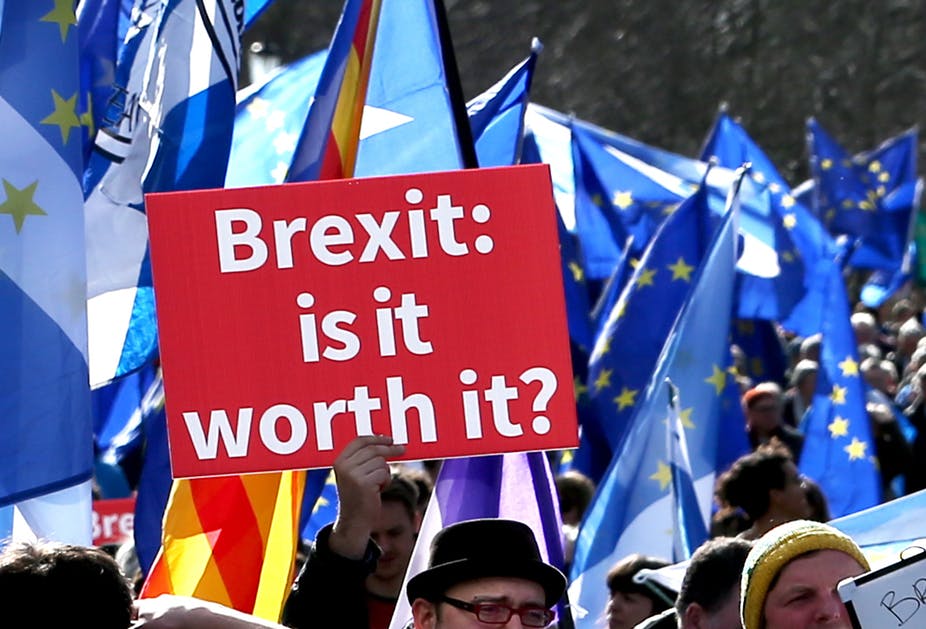(单词翻译:单击)
The hardest part about Brexit is the borders.
脱欧面临的最大阻力在于边境。
As part of the European Union, the United Kingdom's borders have been relatively open for years.
作为欧盟的一部分,多年来,英国边境一直比较开放。
Trade's carried out freely with other member countries and people coming through only need to show their EU passport.
英国和欧盟其他成员国之间可以自由贸易,来往的人员出示欧盟护照即可。
But in June 2016, the UK voted to leave the EU so that it could reassert control on its own borders and decide who and what it wanted to let through.
然而,2016年6月英国投票退出欧盟,以便重新控制自己的边境,自主决定过关人员和物品。
Imagine these boundaries turning into hard borders.
试想这些边境加强管控之后会怎么样?
The impact of that on these maritime borders is complicated in terms of trade,
就贸易而言,这一变化对海洋边界的影响颇为复杂,
but it could have serious implications for the people living along the UK’s only overland border — here.
但对居住在英国唯一的陆上边境,也就是此地的人们而言,这一变化可能会造成严重的影响。
This border, between Northern Ireland and the Republic of Ireland, is one of the reasons why Brexit negotiations continue to reach a deadlock.
英国脱欧谈判仍在僵持跟北爱尔兰和爱尔兰共和国之间的这条边界不无关系。
That’s because this isn’t just a boundary between two countries,
因为这条边界不仅仅是两国之间的界限,
it’s also a compromise, a symbol of identity, a solution to a troubled history.
它也是妥协的结果,是身份的象征,是给那段动荡历史的一个答案。
And it’s been keeping the peace in Northern Ireland for 20 years.
它维持了北爱尔兰20年来的和平。
Hardening this border could put one of Europe’s greatest success stories in jeopardy.
加强这里的边境管控会危及到欧洲最大的成功事迹之一。
This border was first drawn in 1920 by the British, who had ruled over the island for centuries.
这条边界最初是已经统治该岛长达数世纪的英国人于1920年绘制的。
The Irish had rebelled several times, but not everyone wanted the British to leave.
对此爱尔兰人曾多次反抗,但并不是每个人都希望那些英国人离开。
So, eventually the UK divided the island into two states based on its population.
最终,英国根据人口将该岛划入了两个国家。
Most people in this part were historically Catholic, and identified as Irish, and wanted independence.
这一地区的大多数人过去都是天主教徒,给他们的身份是想要独立的爱尔兰人。
They were known as Nationalists.
他们被称为“民族主义者”。
But in the North, many people were Protestant, identified more closely as British and wanted to stay in the UK.
但在北方,很多人都是新教徒,他们的身份更接近英国人的身份,他们则希望留在英国。
They were called Unionists.
他们被称为“联合主义者”。
After the partition, this part remained in the UK as Northern Ireland.
实行分治之后,这部分作为北爱尔兰留在了英国。
We made that decision as a people quite freely, and for very definite reasons. Reasons that are historical, reasons that are cultural, and reasons that are economic.
我们是相当自由地,作为一个民族做出的这一决定,我们有非常明确的理由,是综合考量历史、文化、经济等多个方面的结果。
The south continued to move away from the UK until it gained complete independence and became a new country -the Republic of Ireland.
南部地区继续与英国渐行渐远,直到完全独立,成为一个新的国家 - 爱尔兰共和国。
At first, this 499 kilometer border was pretty porous.
起初,这条499公里的边界出入非常轻松。
But the UK and Ireland continued to be hostile.
但英国和爱尔兰越来越势不两立。
Over time, customs checks were set up at the border crossings and the two countries descended into a trade war.
随着时间的推移,这里的边境口岸就设立起了海关,两国甚至还陷入过贸易战。
Tariffs were placed on agricultural produce and goods like steel and coal.
过关的农产品,钢铁和煤炭等产品也开始要缴纳关税了。
By the late 1960s, things turned violent.
到了20世纪60年代末,两国的矛盾开始升级为暴力冲突。
Violence like this hit Northern Ireland after years of simmering bitterness between the Catholic minority and the ruling Protestant regime.
天主教少数派与执政的新教政权之间的矛盾经过多年的发酵,北爱尔兰的暴力冲突已经发展到了如此地步。
In Northern Ireland, fierce conflict broke out between extremist groups.
北爱尔兰的极端主义团体之间爆发了激烈的冲突。
Nationalist paramilitaries, like the Irish Republican Army, believed that Northern Ireland was rightfully part of Ireland
爱尔兰共和军之类的民族主义准军事组织认为,北爱尔兰是爱尔兰的合法组成部分,
and that the British were oppressors of Northern Ireland's Nationalist population.
北爱尔兰民族主义者受到了英国人的压迫。
Unionist paramilitaries fought back; defending their place in the UK.
联合主义者的准军事组织发起了反击,捍卫他们在英国的地位。
Both groups blew up buildings, set off car bombs, and engaged in bloody street fighting.
双方都炸毁了很多建筑,引爆汽车炸弹,还进行过血腥的街头斗殴。
The UK deployed thousands of troops to Northern Ireland during this time; and became a common target of Nationalist paramilitary attacks.
在此期间,英国向北爱尔兰派遣了数千名士兵,也为此成为了各个民族主义准军事组织发动攻击的共同目标。
Especially at the border, which for Nationalists was the ultimate symbol of British occupation.
特别是在民族主义者认为是英国占领他们的领土最根本的象征的边境地区。
Welsh fuseliers who patrol this stretch of the border described in court as the main battle line between the IRA and the army, have suffered repeated attacks.
而这一边境上,威尔士燧发枪团巡逻的在法庭上被描述为地段爱尔兰共和军与英国军队之间的主要战线的地段遭到了反复的袭击。
As violence surged, the UK military tried to secure the border with walls, towers, heavy guns, and patrols.
随着暴力事件的激增,英国军方试图通过围墙,塔楼,重型枪支和巡逻来保护边界。
They tightly controlled the 20 official crossings and screened people and vehicles passing through.
他们严密控制了20个官方过境点,对过往的人员和车辆进行盘查。


